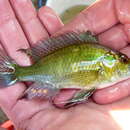Diagnostic Description
provided by Fishbase
Description: moderately slender-bodied; mouth small; frontal profile straight; caudal fin rounded; females smaller than males (Ref. 52307).Coloration: males with several large orange egg spots in anal fin; lower parts of body and breast yellowish; body scales yellowish to pale orange with bluish to silvery margins; upper half of body somewhat darker than lower; rows of orange maculae visible in dorsal and caudal fins; 2 dark longitudinal bands o several dark vertical bars may occasionally be visible on the body; females with a plain, pale silvery to brownish coloration (Ref. 52307).
Life Cycle
provided by Fishbase
Female lays batches of eggs on a substratum which the male begins to inseminate. Female collects the eggs almost immediately after laying a batch and incubates eggs in her mouth for 12-14 days at 26°C, releasing the young after which. Parent guards the young for 5-7 days, keeping them into her mouth when approached by predators or divers.
Biology
provided by Fishbase
Occurs in vegetated areas in shallow water, but also found in rivers and streams around the lake. Feeds on invertebrates, algae, plants, small fishes and plankton (Ref. 5595). Ovophilic, agamous (Ref. 52307) maternal mouthbrooder (Ref. 6307, 52307).
Importance
provided by Fishbase
fisheries: commercial; aquarium: commercial

